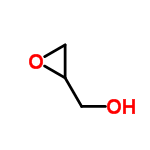(±)-Glycidol C3H6O2 structure – Flashcards
Flashcard maker : Patrick Marsh
Contents
- Experimental Melting Point:
- Experimental Boiling Point:
- Experimental Vapor Pressure:
- Experimental Flash Point:
- Experimental Freezing Point:
- Experimental Gravity:
- Experimental Refraction Index:
- Experimental Solubility:
- Appearance:
- Stability:
- Toxicity:
- Safety:
- First-Aid:
- Exposure Routes:
- Symptoms:
- Target Organs:
- Incompatibility:
- Personal Protection:
- Exposure Limits:
- Retention Index (Kovats):
- Retention Index (Normal Alkane):

| Molecular Formula | C3H6O2 |
| Average mass | 74.078 Da |
| Density | 1.2±0.1 g/cm3 |
| Boiling Point | 162.4±8.0 °C at 760 mmHg |
| Flash Point | 81.1±0.0 °C |
| Molar Refractivity | 17.1±0.3 cm3 |
| Polarizability | 6.8±0.5 10-24cm3 |
| Surface Tension | 48.4±3.0 dyne/cm |
| Molar Volume | 62.9±3.0 cm3 |
- Experimental data
- Predicted – ACD/Labs
- Predicted – EPISuite
- Predicted – ChemAxon
- Experimental Physico-chemical Properties
- Miscellaneous
- Gas Chromatography
Predicted data is generated using the ACD/Labs Percepta Platform – PhysChem Module
| Density: | 1.2±0.1 g/cm3 |
| Boiling Point: | 162.4±8.0 °C at 760 mmHg |
| Vapour Pressure: | 0.7±0.7 mmHg at 25°C |
| Enthalpy of Vaporization: | 46.5±6.0 kJ/mol |
| Flash Point: | 81.1±0.0 °C |
| Index of Refraction: | 1.455 |
| Molar Refractivity: | 17.1±0.3 cm3 |
| #H bond acceptors: | 2 |
| #H bond donors: | 1 |
| #Freely Rotating Bonds: | 1 |
| #Rule of 5 Violations: | 0 |
| ACD/LogP: | -0.95 |
| ACD/LogD (pH 5.5): | -0.74 |
| ACD/BCF (pH 5.5): | 1.00 |
| ACD/KOC (pH 5.5): | 9.44 |
| ACD/LogD (pH 7.4): | -0.74 |
| ACD/BCF (pH 7.4): | 1.00 |
| ACD/KOC (pH 7.4): | 9.44 |
| Polar Surface Area: | 33 Å2 |
| Polarizability: | 6.8±0.5 10-24cm3 |
| Surface Tension: | 48.4±3.0 dyne/cm |
| Molar Volume: | 62.9±3.0 cm3 |
Predicted data is generated using the US Environmental Protection Agency’s EPISuite™
Log Octanol-Water Partition Coef (SRC): Log Kow (KOWWIN v1.67 estimate) = -1.09 Log Kow (Exper. database match) = -0.95 Exper. Ref: Deneer,JW et al. (1988) Boiling Pt, Melting Pt, Vapor Pressure Estimations (MPBPWIN v1.42): Boiling Pt (deg C): 124.16 (Adapted Stein & Brown method) Melting Pt (deg C): -42.71 (Mean or Weighted MP) VP(mm Hg,25 deg C): 5.59 (Mean VP of Antoine & Grain methods) BP (exp database): 66 @ 2.5 mm Hg deg C Water Solubility Estimate from Log Kow (WSKOW v1.41): Water Solubility at 25 deg C (mg/L): 1e+006 log Kow used: -0.95 (expkow database) no-melting pt equation used Water Sol (Exper. database match) = 1e+006 mg/L (20 deg C) Exper. Ref: YALKOWSKY,SH & DANNENFELSER,RM (1992) Water Sol Estimate from Fragments: Wat Sol (v1.01 est) = 1e+006 mg/L Wat Sol (Exper. database match) = 1000000.00 Exper. Ref: YALKOWSKY,SH & DANNENFELSER,RM (1992) ECOSAR Class Program (ECOSAR v0.99h): Class(es) found: Epoxides Henrys Law Constant (25 deg C) [HENRYWIN v3.10]: Bond Method : 5.84E-009 atm-m3/mole Group Method: 1.41E-009 atm-m3/mole Henrys LC [VP/WSol estimate using EPI values]: 5.449E-007 atm-m3/mole Log Octanol-Air Partition Coefficient (25 deg C) [KOAWIN v1.10]: Log Kow used: -0.95 (exp database) Log Kaw used: -6.622 (HenryWin est) Log Koa (KOAWIN v1.10 estimate): 5.672 Log Koa (experimental database): None Probability of Rapid Biodegradation (BIOWIN v4.10): Biowin1 (Linear Model) : 0.5236 Biowin2 (Non-Linear Model) : 0.4122 Expert Survey Biodegradation Results: Biowin3 (Ultimate Survey Model): 3.1868 (weeks ) Biowin4 (Primary Survey Model) : 3.8606 (days ) MITI Biodegradation Probability: Biowin5 (MITI Linear Model) : 0.7359 Biowin6 (MITI Non-Linear Model): 0.8606 Anaerobic Biodegradation Probability: Biowin7 (Anaerobic Linear Model): 0.6570 Ready Biodegradability Prediction: YES Hydrocarbon Biodegradation (BioHCwin v1.01): Structure incompatible with current estimation method! Sorption to aerosols (25 Dec C)[AEROWIN v1.00]: Vapor pressure (liquid/subcooled): 683 Pa (5.12 mm Hg) Log Koa (Koawin est ): 5.672 Kp (particle/gas partition coef. (m3/ug)): Mackay model : 4.39E-009 Octanol/air (Koa) model: 1.15E-007 Fraction sorbed to airborne particulates (phi): Junge-Pankow model : 1.59E-007 Mackay model : 3.52E-007 Octanol/air (Koa) model: 9.23E-006 Atmospheric Oxidation (25 deg C) [AopWin v1.92]: Hydroxyl Radicals Reaction: OVERALL OH Rate Constant = 4.6591 E-12 cm3/molecule-sec Half-Life = 2.296 Days (12-hr day; 1.5E6 OH/cm3) Half-Life = 27.549 Hrs Ozone Reaction: No Ozone Reaction Estimation Fraction sorbed to airborne particulates (phi): 2.55E-007 (Junge,Mackay) Note: the sorbed fraction may be resistant to atmospheric oxidation Soil Adsorption Coefficient (PCKOCWIN v1.66): Koc : 1 Log Koc: 0.000 Aqueous Base/Acid-Catalyzed Hydrolysis (25 deg C) [HYDROWIN v1.67]: Total Ka (acid-catalyzed) at 25 deg C : 3.489E-003 L/mol-sec Ka Half-Life at pH 7: 62.957 years Bioaccumulation Estimates from Log Kow (BCFWIN v2.17): Log BCF from regression-based method = 0.500 (BCF = 3.162) log Kow used: -0.95 (expkow database) Volatilization from Water: Henry LC: 5.84E-009 atm-m3/mole (estimated by Bond SAR Method) Half-Life from Model River: 8.629E+004 hours (3595 days) Half-Life from Model Lake : 9.414E+005 hours (3.923E+004 days) Removal In Wastewater Treatment: Total removal: 1.85 percent Total biodegradation: 0.09 percent Total sludge adsorption: 1.75 percent Total to Air: 0.00 percent (using 10000 hr Bio P,A,S) Level III Fugacity Model: Mass Amount Half-Life Emissions (percent) (hr) (kg/hr) Air 0.134 55.1 1000 Water 39.2 360 1000 Soil 60.6 720 1000 Sediment 0.0718 3.24e+003 0 Persistence Time: 568 hr
Click to predict properties on the Chemicalize site


